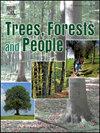Social vulnerability and family forest owners in the United States
IF 2.7
Q1 FORESTRY
引用次数: 0
Abstract
Social equity, and the related topic of social vulnerability, is an important issue that is impacting many facets of society, including forests. A substantial portion, 39 %, of forests in the United States are owned by families, individuals, trusts, estates, and family partnerships, collectively referred to as family forest owners. There are many programs and services intended to help family forest owners conserve and better manage their land, but participation rates are relatively low, the efficacy of many programs has been called into question, and the social equitability of access is largely unknown. The social vulnerability of family forest owners in the United States was assessed by intersecting data from the US Centers for Disease Control and Prevention and the US Agency for Toxic Substances and Disease Registry's Social Vulnerability Index (SVI) with data from the USDA Forest Service's National Woodland Owner Survey. Family forest owners have a similar SVI compared to the general US population, but the values vary substantially for some SVI themes including family forest owners having higher values for SVI Theme 2 (household composition and disabilities) and lower values for SVI Themes 3 (minority status and language) and 4 (housing type and transportation). Based on logistic regression models, the relationships among social vulnerability metrics and selected family forest owner attributes were found to vary. SVI Theme 1 (socioeconomic status) has positive relationships with amenity and financial ownership objectives, timber harvesting, collection of nontimber forest products, and recreational activity and negative relationships with management plans and advice. SVI Theme 2 has negative relationships with timber harvesting, management plans, advice, and program participation. SVI Theme 3 has negative relationships with timber harvesting, collection of nontimber forest products, and recreational activity. SVI Theme 4 has a positive relationship with collection of nontimber forest products. Programs and services could be redesigned and retargeted to maintain and enhance the social benefits that are accruing and mitigate the shortcomings.
美国的社会脆弱性和家庭森林所有者
社会公平以及与之相关的社会脆弱性问题是一个影响到包括森林在内的社会许多方面的重要问题。美国39%的森林由家庭、个人、信托、地产和家庭合伙企业所有,统称为家庭森林所有者。有许多项目和服务旨在帮助家庭森林所有者保护和更好地管理他们的土地,但参与率相对较低,许多项目的有效性受到质疑,而且获取的社会公平性在很大程度上是未知的。通过将美国疾病控制和预防中心、美国有毒物质和疾病登记处的社会脆弱性指数(SVI)数据与美国农业部林务局的全国林地所有者调查数据相交叉,评估了美国家庭森林所有者的社会脆弱性。与一般美国人口相比,家庭森林所有者具有相似的SVI,但某些SVI主题的值差异很大,包括家庭森林所有者SVI主题2(家庭组成和残疾)的值较高,SVI主题3(少数民族地位和语言)和SVI主题4(住房类型和交通)的值较低。基于logistic回归模型,发现社会脆弱性指标与选定家庭林主属性之间的关系存在差异。SVI主题1(社会经济地位)与舒适和财务所有权目标、木材采伐、非木材林产品收集和娱乐活动呈正相关,与管理计划和建议呈负相关。SVI主题2与木材采伐、管理计划、建议和项目参与呈负相关。SVI主题3与木材采伐、非木材林产品收集和娱乐活动呈负相关。SVI主题4与非用材林产品采集量呈正相关。项目和服务可以重新设计,重新定位,以保持和提高正在积累的社会效益,并减轻缺点。
本文章由计算机程序翻译,如有差异,请以英文原文为准。
求助全文
约1分钟内获得全文
求助全文
来源期刊

Trees, Forests and People
Economics, Econometrics and Finance-Economics, Econometrics and Finance (miscellaneous)
CiteScore
4.30
自引率
7.40%
发文量
172
审稿时长
56 days
 求助内容:
求助内容: 应助结果提醒方式:
应助结果提醒方式:


